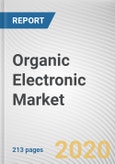Organic electronics are unlike conventional inorganic semiconductors, organic electronic materials are architecture using organic (carbon-based) polymers or molecules using artificial technology developed in the context of organic & polymer chemistry. The organic electronics use various material such as semiconductor material, conductive material and dielectric & substrate material for construction. Further, these is used in various applications such as that of displays, lighting, battery, conductive ink and others.
Increase in demand due to adoption of technologies supporting sustainable development, demand for various applications, and need of organic electronic in latest technologies are the factors that drive the organic electronic market growth. Whereas, degradation of efficiency of organic electronics after a period and technical in-compatibility hamper the organic electronic market growth. However, the increase in R&D activities for various applications is expected to create organic electronic market opportunity.
As per the organic electronic market analysis, the market is segmented into material, application and region. The material is further categorized into semiconductor, conductive and dielectric & substrate. The application segment is classified into display, lighting, battery, conductive ink and others. Region wise, the market is analyzed across North America, Europe, Asia-Pacific, and LAMEA.
Key Players which have a major organic electronic market share include AGC INC., BASF SE, COVESTRO AG, Evonik Industries AG, H.C. Starck Inc., Heliatek GmbH, Merck Group, Novaled GmbH, POLYIC GMBH & CO. KG and Sumitomo Corporation, which are profiled in this report.
ORGANIC ELECTRONIC SEGMENTATION
By Material
- Semiconductor
- Conductive
- Dielectric and Substrate
By Application
- Display
- Lighting
- Battery
- Conductive ink
- Others
By Region
- North America
- U.S.
- Canada
- Mexico
- Europe
- Germany
- France
- UK
- Rest of Europe
- Asia-Pacific
- China
- Japan
- India
- Australia
- Rest of Asia-Pacific
- LAMEA
- Latin America
- Middle East
- Africa
Key Players
- AGC INC.
- BASF SE
- COVESTRO AG
- Evonik Industries AG
- H.C. Starck Inc.
- Heliatek GmbH
- Merck Group
- Novaled GmbH
- POLYIC GMBH & CO. KG
- Sumitomo Corporation
Table of Contents
Companies Mentioned
- AGC Inc.
- BASF SE
- Covestro AG
- Evonik Industries AG
- H. C. Starck Inc.
- Heliatek GmbH
- Merck KGaA
- Novaled GmbH
- Polyic GmbH & Co. KG
- Sumitomo Corporation
Methodology
The analyst offers exhaustive research and analysis based on a wide variety of factual inputs, which largely include interviews with industry participants, reliable statistics, and regional intelligence. The in-house industry experts play an instrumental role in designing analytic tools and models, tailored to the requirements of a particular industry segment. The primary research efforts include reaching out participants through mail, tele-conversations, referrals, professional networks, and face-to-face interactions.
They are also in professional corporate relations with various companies that allow them greater flexibility for reaching out to industry participants and commentators for interviews and discussions.
They also refer to a broad array of industry sources for their secondary research, which typically include; however, not limited to:
- Company SEC filings, annual reports, company websites, broker & financial reports, and investor presentations for competitive scenario and shape of the industry
- Scientific and technical writings for product information and related preemptions
- Regional government and statistical databases for macro analysis
- Authentic news articles and other related releases for market evaluation
- Internal and external proprietary databases, key market indicators, and relevant press releases for market estimates and forecast
Furthermore, the accuracy of the data will be analyzed and validated by conducting additional primaries with various industry experts and KOLs. They also provide robust post-sales support to clients.

LOADING...








